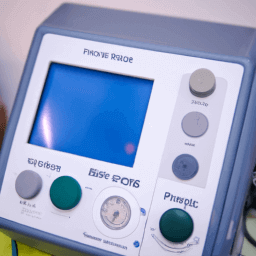What are the types of BP machines and their usage?
Umar Shareef
There are two main types of blood pressure machines: manual and automatic. Manual machines require the use of a stethoscope and a cuff that is manually inflated and deflated. Automatic machines use an electronic sensor to detect blood pressure and inflate and deflate the cuff automatically. Both types of machines are used to measure blood pressure and can be found in medical settings, as well as in homes for personal use. It is important to follow the instructions for use carefully to ensure accurate readings.
Types of BP Machines and Their Usage
Blood pressure (BP) machines are medical devices used to measure the pressure of blood in the arteries. High blood pressure or hypertension is a common health problem that affects millions of people worldwide. BP machines are essential tools for monitoring and managing hypertension. There are several types of BP machines available in the market, each with its own advantages and disadvantages. In this article, we will discuss the different types of BP machines and their usage.Manual BP Machines
Manual BP machines, also known as aneroid sphygmomanometers, are the most traditional type of BP machines. They consist of a cuff, a pressure gauge, and a stethoscope. The cuff is wrapped around the upper arm, and the pressure gauge is used to measure the pressure in the cuff. The healthcare professional uses the stethoscope to listen to the sounds of blood flowing through the arteries. The pressure is then recorded as two numbers, the systolic pressure (the higher number) and the diastolic pressure (the lower number). Manual BP machines are accurate and reliable, but they require proper training and expertise to use. They are commonly used in hospitals, clinics, and doctor's offices. However, they are not suitable for home use as they require a trained professional to operate.Automatic BP Machines
Automatic BP machines, also known as digital or electronic BP machines, are the most popular type of BP machines used at home. They are easy to use and do not require any special training. They consist of a cuff, a display screen, and a pump that inflates the cuff. The machine automatically detects the pressure in the cuff and displays the readings on the screen. Automatic BP machines are available in two types, wrist and arm. Wrist BP machines are smaller and more portable than arm BP machines, but they are less accurate and can be affected by the position of the wrist. Arm BP machines are more accurate and reliable, but they are bulkier and less portable.Finger BP Machines
Finger BP machines, also known as pulse oximeters, are small and portable devices that measure the oxygen saturation and pulse rate in the blood. They are commonly used in hospitals and clinics to monitor patients with respiratory problems. However, they are not suitable for measuring blood pressure as they do not provide accurate readings.Ambulatory BP Monitors
Ambulatory BP monitors are portable devices that are worn by the patient for 24 hours to monitor their blood pressure. They consist of a cuff, a small computer, and a belt that holds the device in place. The device automatically inflates the cuff at regular intervals throughout the day and night, recording the readings in the computer. Ambulatory BP monitors are used to diagnose and monitor hypertension, especially in patients who have fluctuating blood pressure levels. They provide a more accurate and comprehensive picture of the patient's blood pressure than a single reading taken in a doctor's office.Comparison Table
| Type of BP Machine | Usage | Advantages | Disadvantages |
|---|---|---|---|
| Manual BP Machines | Hospitals, clinics, doctor's offices | Accurate and reliable | Require proper training and expertise to use, not suitable for home use |
| Automatic BP Machines | Home use | Easy to use, do not require special training | Less accurate than manual BP machines, wrist BP machines can be affected by wrist position |
| Finger BP Machines | Not suitable for measuring blood pressure | Small and portable, used to measure oxygen saturation and pulse rate | Do not provide accurate readings of blood pressure |
| Ambulatory BP Monitors | 24-hour monitoring of blood pressure | Provide a more accurate and comprehensive picture of blood pressure than a single reading, useful for diagnosing and monitoring hypertension | Bulky and less portable, can be uncomfortable to wear for 24 hours |
| By www.zelect.in | |||
Conclusion
BP machines are essential tools for monitoring and managing hypertension. There are several types of BP machines available in the market, each with its own advantages and disadvantages. Manual BP machines are accurate and reliable, but they require proper training and expertise to use. Automatic BP machines are easy to use and suitable for home use, but they are less accurate than manual BP machines. Finger BP machines are not suitable for measuring blood pressure. Ambulatory BP monitors provide a more accurate and comprehensive picture of the patient's blood pressure, but they are bulky and less portable. It is important to choose the right type of BP machine based on your needs and preferences.Sharing is caring!
Facebook Twitter Email
Recommended articles for BP Machine
BP Machine types and buying guide
-
How to Choose the Right Cuff Size for Your BP Machine?
-
Can BP machine be wrong?
-
What is pulse in BP machine?
-
What is sys and dia in BP machine?
-
Which BP machine is accurate
-
Why digital BP machine show different readings?
-
Is manual BP machine accurate?
-
Is wrist BP machine accurate?
-
Is digital BP machine accurate?
-
Does BP machine shows heart rate?
-
BP machine buying guide. Things to know before buy?
-
Are Wrist BP Machines as Accurate as Arm BP Machines?
-
The Difference Between Manual and Digital BP Machines?
-
How to Choose the Best BP Machine for Accurate Readings?
-
Which brand is best for BP machine?
-
Is digital BP machine accurate?
-
Which BP machine is accurate digital or manual?
-
Which BP machine is best for home use digital or manual?
-
What are the types of BP machines and their usage?


